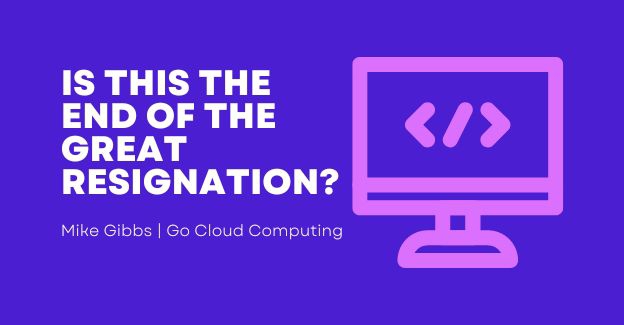What is the state of the Great Resignation for employers and job seekers asks Mike Gibbs, CEO of Go Cloud Careers. He looks at the factors that originally drove people from their jobs and the transition to a focus on advancement.
There are a lot of factors that led up to the labor trend that has come to be known as the Great Resignation, including some that were in play before the pandemic began.
For example, the baby boomers were an aging demographic starting to retire during this season. Additionally, there’s a population migration of people leaving jobs in high-tax or expensive-to-live areas such as New York City and the San Francisco Bay area to relocate to places like Texas and Florida where they can find either lower taxes, a lower cost of living or a more friendly business environment. When the circumstances of the pandemic were added to these factors, it made things a lot worse.
Tech and Health Care Workers Pushed to Their Limits
Initially, the pandemic affected two sets of employees who were pushed to their limits: health care workers and technology workers. Health care professionals were working non-stop at hospitals caring for Covid patients, especially when we did not have the therapeutics to treat the disease.
IT professionals were also taxed. Prior to the pandemic, we were used to people working in the office. But out of nowhere, IT professionals were called upon to create remote access environments to allow work to continue during the pandemic. This required the creation of a new technology infrastructure and supporting a work-from-home workforce versus an in-office workforce. To accomplish this, technology professionals had extremely huge demands placed on them for the past two years.
Predominantly, the industries that saw the most change were healthcare and IT, but not exclusively. Workers across a wide range of industries have been affected.
New Work Environments Add to Workplace Tension
We went from working in normal office settings during normal office hours to much more stressful environments. Now it seems as if we are in meetings 24 hours a day, seven days a week. Before the shift to remote offices, we would go to the office and we would leave the office at five o'clock, six o'clock or even seven o'clock. Regardless of the time, eventually we would go home.
When you work from home, however, there is no stopping. You could be getting phone calls at six o'clock in the morning and you can be on Zoom meetings until midnight. We are at many more meetings because the managers can’t see what employees are doing during the workday like they could in the office. We have no boundaries, which means people are asking us, calling us and texting us 24 hours a day.
The work overload we experienced in this new environment – being constantly on-call and always in meetings – has been challenging for some people. The socialization that occurred at work disappeared. When you are not able to hang out by the water cooler and talk to each other, you are always going to be working. Without this socialization, we went from spending our days in a half-work, half-social place to a whole-work place with no boundaries.
Many Workers Want Better Pay and Conditions
As the controls put in place because of the pandemic began to lift, we started to see workers looking for different work situations. Instead of short-term contract situations, they started searching for long-term positions.
People were also looking to leave lower-paying jobs in the aftermath of the pandemic. A great reshuffling occurred in the hotel and the food industry where people are looking for higher-paying jobs. We have seen a migration from lower-paying jobs toward higher-paying jobs, and a migration from in-office jobs to work-from-home jobs.
Cost of Living Increases May Drive Additional Shifts
Now we are in a new environment with new circumstances that have the potential to prolong the Great Resignation. This hyper-inflationary state will cause one of two things to occur. Organizations can make strides to keep employees by increasing salaries. This would require organizations to raise the prices of their goods and services to provide resources to accommodate the higher salaries, which will cause runaway inflation.
If organizations were able to increase wages to keep up with the inflation rate, we would see employees staying in the office. If not, then employees are effectively taking an eight-to-10% pay cut with the current aggregate rates of inflation. That would result in many more people quitting their jobs and looking for other opportunities.
In addition, we are starting to see people called back to the office. This could also result in more resignations. There are people who are scared to go to the office due to health and other considerations. People are quitting their jobs just from the fear of going to the office and looking for work that allows them to continue to be remote.
From increased workloads to new salary demands to new workplace expectations, there are many factors that could prolong the creation of environments in which the Great Resignation can continue. We may have seen the worst of it, but we have not seen the end of it.







